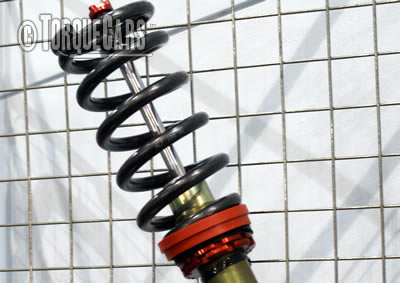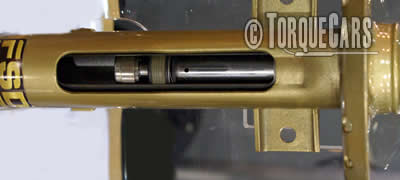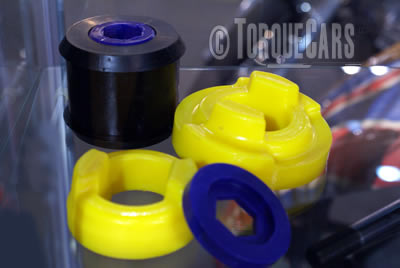Fine tuning your suspension setup for your driving style.
"Thank you for reading our comprehensive suspension setting guide"

Many people just concentrate on lowering the car and assume that stiffer springs and the lower ride height will improve handling.
However there are many other settings for your suspension which can make a massive difference to the handling before you even think about changing components.
The shocks are generally a piston inside a liquid and some have an additional gas chamber to absorb shocks (gas compresses whereas liquid does not compress under pressure.)
Shocks can have a fairly complicated structure.
Testing the shocks on your car you bounce the car – if you get more than one bounce then your shock are on the way out.
Without shocks the car would drive like a thing on a spring and just bounce everywhere.
(Damper – the shock absorber).
Bound & Rebound settings
This is the dampening force of the shock absorber. Bound is the rate at which the shock allows compression and rebound is the rate at which the shock releases the compression.
If your suspension has a dampening control then you can play with these settings and get the optimum setting. Electronic in car adjustments is now possible and if you are considering drifting your car you really should invest in one of these set-ups.

What is Camber
This is the angle of the wheel to the road. If you put all of your weight on the outside of your feet you would have a positive camber and if you rolled your feet inwards so all your weight is on the inside you get negative camber.
As the car rolls into a corner the camber can make a big difference to handling and also tyre life. Sadly the best camber setting for handling will cause premature wear to the tyres!
Front wheels are set up to get negative camber as the wheel is deflected up. The camber setting is the angle of the wheel to the road as well as the angle of the wheel to the chassis. As the car corners and rolls the suspension geometry must maintain the best angle of contact of the tyre to the road.
This is why manufacturers go to such great lengths to set up their cars correctly and when you make suspension modifications it should be your aim to keep as close to the makers spec as possible.
Generally the more tuned the suspension set-up the less variation there is under stress and the less room you have to play with.
Start off with the manufacturers settings and alter these slightly increasing the negative camber and test the results. If you can’t feel any difference then why are you bothering!
Remember that kerbing wheels and hitting bumps can knock out the camber setting. Tyre temperature alters the camber so the camber is best set with warm tyres!
What is Caster
Imagine it is a windy day and you lean forwards – your legs now have a negative caster.
The angle of the wheel hub in relation to the suspension arm is described as the angle of caster.
The positive caster keeps the wheel straight when going along – a bit like a pram wheel the connecting arm to the hub is set slightly back. Stability results whereas a neutral camber would result in the wheel wobbling around the axis.
The angle a car wheel is set at generates more camber when the wheel is turned.
What is Toe in and out and what does it do?
Stand like Charlie chaplain with your heels together and your toes out. Now imagine your cars tyres are at this angle too – this is known as Toe Out.
Toe in is where your heels are apart and the toes are together. Obviously the angle of Toe in a car is barely perceptible.
The effect of this setting on the car is stability – toe out gives great stability on the straight and the car resists a turn to the right or left.
Toe out gives a much quicker steering response.
Some people simplify this and say that Toe in is a preferred road car setting and Toe out is a track setting .
The drive and suspension geometry of the car comes into play here and some road cars need toe moving towards the negative, and some perform better with it a degree or so towards the positive.
At the end of the day it entirely up to you to decide how much Toe you want and what feels right in your car, with your driving style on typical roads you use.
Toe applies equally to the rear tyres although they are generally set as a lower angle than the fronts.
Eliminating roll
Eliminating roll in corners helps cornering stability and keeps all four wheels on the ground.
When pushed really hard most production cars will lift a rear wheel of the ground and when cornering you really need as much rubber in contact with the black stuff as possible.
The roll bar also known as a sway bar helps to keep the car level in a corner by taking the lift from one side and trying to move it to the other.
As this is not possible the lift is effectively pulled down and everything is kept in contact with the road.
Strut braces stiffen the top of the suspension mountings and help reduce flex when you are pushing the car hard so also have a minor benefit at reducing roll.

Spring stiffness
If the springs are too stiff the car will bounce over humps and lumps in the road.
If it is too soft the car will just wallow along (it’ll be a really comfortable ride though).
The best shocks are adjustable on the car and let you get the set up perfect to match your driving style.
If you have slightly softer springs on the front the nose of the car will grip in corners and you will have more oversteer (back gets lighter and tends to go wide in corners). If the soft springs are on the back you will get understeer, which is how most production cars are set up nowadays because the inexperienced driver reacts better to understeer than oversteer.

Bushes (bushings)
These connect the suspension components to the chassis of the car. The rubber ones deteriorate in time.
New polyurethane bushes last longer and keep the handling much tighter but because they are harder they can make the ride a little more bumpy.
They can also accelerate wear on other suspension components.
A set of new poly bushes will sharpen up the handling of your car reducing the slop and sway associated with rubber ones.
You can get a full set of suspension bushes for most cars although rarer models often only have the main bushes available in polyurethane.
Custom bushes can often be made up to suit your application.
A new set of OEM rubber bushings will make a massive difference to your cars handling.
Please join us in our friendly forum to catch up with the latest trends in tuning and car modification for your car.
Please Check out my YouTube channel, we're regularly adding new content...
PLEASE HELP: I NEED YOUR DONATIONS TO COVER THE COSTS OF RUNNING THIS SITE AND KEEP IT RUNNING. I do not charge you to access this website and it saves most TorqueCars readers $100's each year - but we are NON PROFIT and not even covering our costs. To keep us running PLEASE Donate here
If you liked this page please share it with your friends, drop a link to it in your favourite forum or use the bookmarking options to save it to your social media profile.
Feedback - What do You Think?
Please use our forums if you wish to ask a tuning question, and please note we do not sell parts or services, we are just an online magazine.
Help us improve, leave a suggestion or tip
Please watch this video and subscribe to my YouTube channel.
5 Responses to “Suspension setup and suspension settings and fine tuning.”

 Click to accept YouTube Cookies & Play.
Click to accept YouTube Cookies & Play.
Why exactly is toe in a road car setting? OK it offers more straightline stability which is generally desired for road cars.But isn’t that too easily put?
Toe in, front or rear, provides stability to handling characteristics. Toe out, front or rear, reduces stability and promotes faster changes to the car’s behavior. I autocross regularly and have my suspension set to .5 deg toe out in front and .25 deg toe in on the rear tires. This helps my car turn in crisply, but it also keeps the rear tires from kicking out and sliding suddenly. I hope this helps.
OK, I think this article is a good guide where to start with changing the setting. My Miata has sway bar tip ends. If you lower the car it is imporant to change the setting of these to keep the corect angle between sway bar and wishbone
I AM DRIVINGNISSAN SUNNY BUT ALL THE FOUR TYRES ARE WEARING INSIDE I DONT KNOW WHAT THE PROBLEM IS
When you picture the cars wheel alignment you have to remember that a car is a highly dynamic system.The relationship of the wheels to the road and suspension when stood still is in a sense deceptive because the alignment is set for the car on the road at speed.It sounds obvious but a straight forward example explains and answers Marcos question.
How does toe in promote straight line stability ??
When the car is traveling forward at speed the forward momentum plus drag/ resistance/friction will try and push the wheels outwards so if they are set very sightly pointing inwards when sitting still this natural tendency will effectively straighten them and square them up to the road so that they are now fully straight ahead and putting the ideal amount of rubber on the road.It isn’t quite as simpe as toe in for the road/toe out for racing because some cars are RWD some FWD and some 4WD.There’s a big difference between the front wheels being under power or being pushed by the rear because one has it’s own torque being transmitted through it and the other doesn’t which we all know has a significant effect on how they behave.
Camber is exactly the same,it may seem odd to have them slightly leaning in but again at speed when there are cornering forces at play,wheel loading and body roll the outside wheel will be pushed square onto the road again.Also the nature of the suspension will have an effect.
Obviously none of us have ever driven too hard down country roads except on private land,that goes without saying lol but I’m sure we’re all familiar with the kind of forces and work those wheels and tyres are taking under some ‘positive’ driving conditions so you e=really do want them to be in the right position under stress rather than when trolling round a car park 🙂